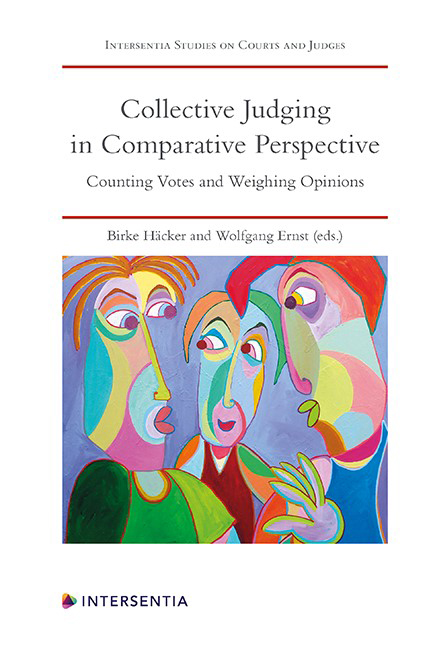Book contents
- Frontmatter
- Preface
- Contents
- List of Cases
- List of Contributors
- PART I DESIGNING COLLEGIATE COURTS’DECISION-MAKING PROCESSES
- PART II COLLEGIATE COURTS IN THE COMMON LAW TRADITION
- PART III COLLEGIATE COURTS IN THE EUROPEAN CIVIL LAW TRADITION
- PART IV COLLEGIATE COURTS IN A NON-EUROPEAN CIVIL LAW JURISDICTION: THE CASE OF JAPAN
- PART V SUPRANATIONAL AND INTERNATIONAL COLLEGIATE COURTS
- PART VI VOICES FROM THE AUDIENCE AND CLOSING REMARKS
- About the Editors
Chapter 12 - The Fine-Mechanics of Judicial Decision-Making at the European Court of Human Rights
Published online by Cambridge University Press: 09 February 2021
- Frontmatter
- Preface
- Contents
- List of Cases
- List of Contributors
- PART I DESIGNING COLLEGIATE COURTS’DECISION-MAKING PROCESSES
- PART II COLLEGIATE COURTS IN THE COMMON LAW TRADITION
- PART III COLLEGIATE COURTS IN THE EUROPEAN CIVIL LAW TRADITION
- PART IV COLLEGIATE COURTS IN A NON-EUROPEAN CIVIL LAW JURISDICTION: THE CASE OF JAPAN
- PART V SUPRANATIONAL AND INTERNATIONAL COLLEGIATE COURTS
- PART VI VOICES FROM THE AUDIENCE AND CLOSING REMARKS
- About the Editors
Summary
COURTS AS BLACK BOXES?
Judges are bound by their oath. At the European Court of Human Rights (ECtHR) every judge, before being allowed to form part of a decision-making body, has solemnly to declare ‘to keep secret all deliberations’. As a natural consequence of this collective promise of silence, the Court seems to be transformed into a black box. Facts and judicial arguments are put in on one side, judgments come out on the other side. What happens in between remains in the realm of mystery.
But: transparency is an important value in a system based on the rule of law. To a certain extent, it might even be considered a precondition for the acceptance of judgments in the ‘outside world’. Judgments without adequate reasoning are considered to be incompatible with basic requirements of fair trial – a standard well entrenched in the jurisprudence of the European Court of Human Rights itself. Nevertheless, the reasoning is communicated to the outside world as a whole, not as work in progress. The mechanics of putting the arguments together, of moulding them into a specific form, smoothening them if necessary, is not visible from outside.
In reality, however, the black box is not as ‘black’ as it might appear to be. Neither is it really non-transparent. Many signs show that the decision-making process can be cumbersome and that it is all but easy to make 17 European judges in Grand Chamber cases or seven European judges in Chamber cases speak with one voice. Very often they do not find a compromise acceptable to all, but write dissenting and concurring opinions and explain their personal convictions. Furthermore, whenever judges ask questions in public hearings, this might betray their preoccupations and reflections, even if the questions are worded in a neutral manner.
The decision-making process at the ECtHR is worthy of consideration in many respects, not least as it is an international court with judges coming from 47 different (European) jurisdictions, having a variety of professional, social and personal backgrounds and working together only for a limited period of time. At the same time, their judgments have to be acceptable in 47 different jurisdictions. So they are not only bound to speak with a common legal language, but this common legal language also has to be understood everywhere in Europe.
- Type
- Chapter
- Information
- Collective Judging in Comparative PerspectiveCounting Votes and Weighing Opinions, pp. 227 - 252Publisher: IntersentiaPrint publication year: 2020

